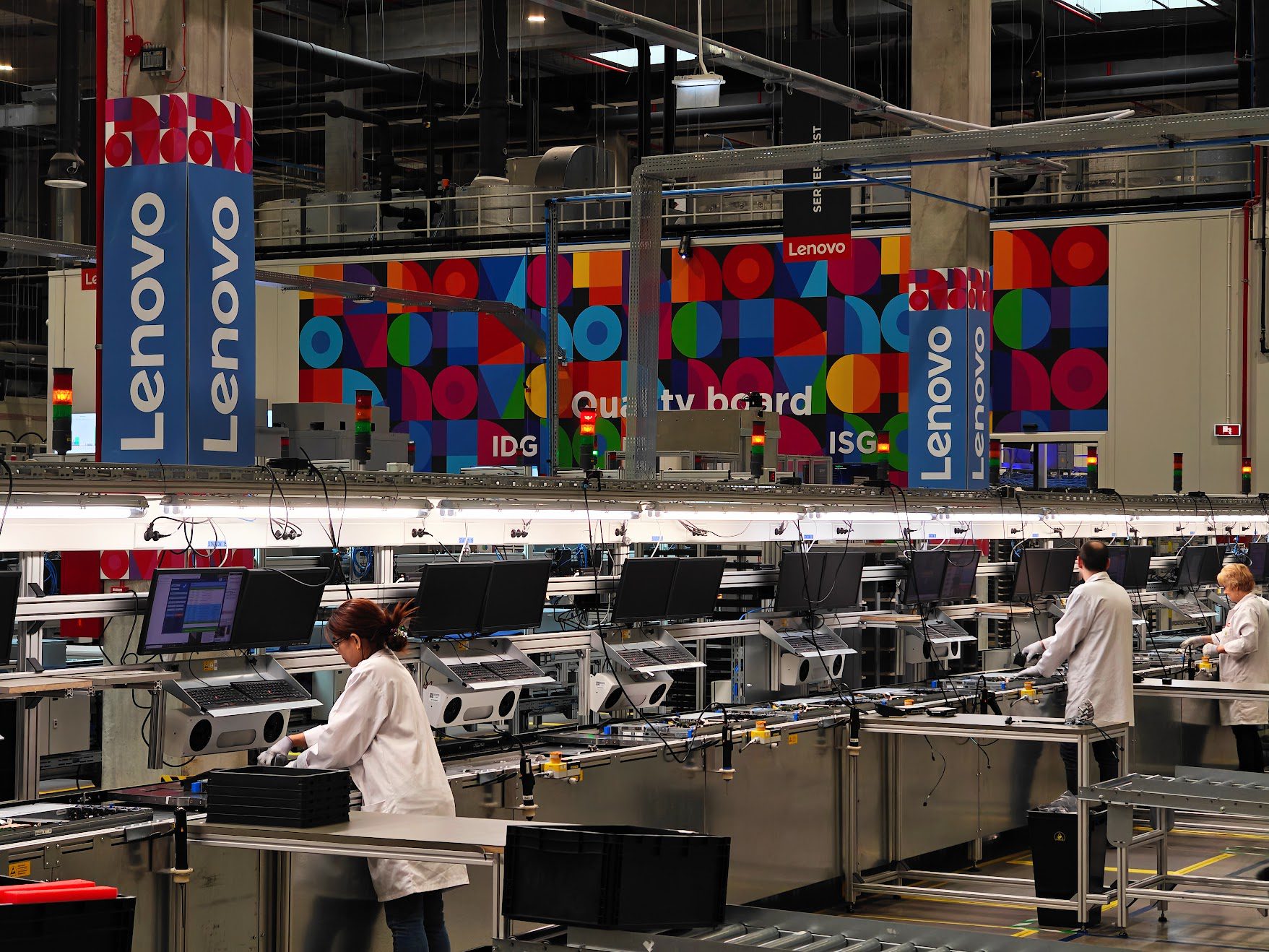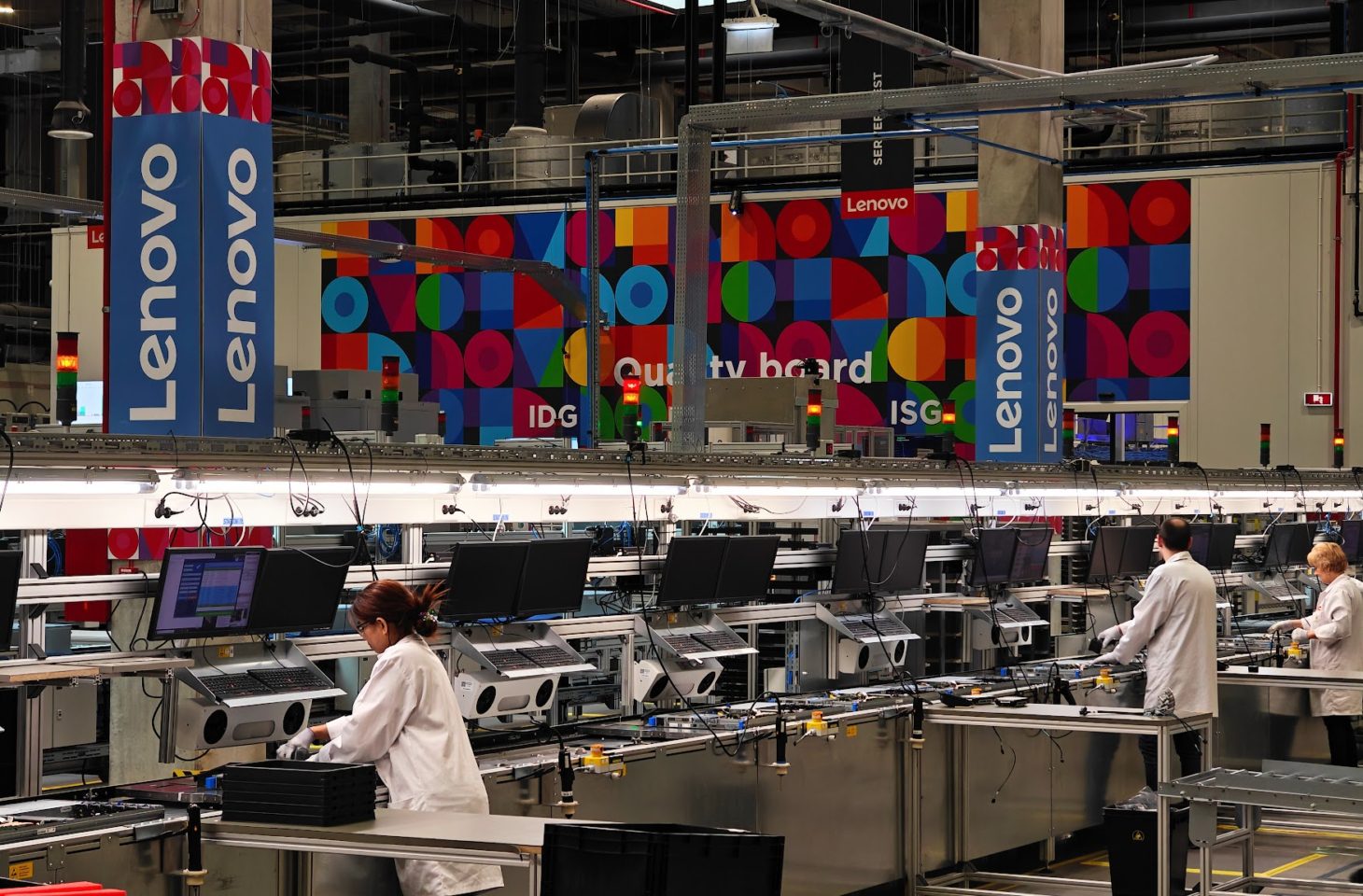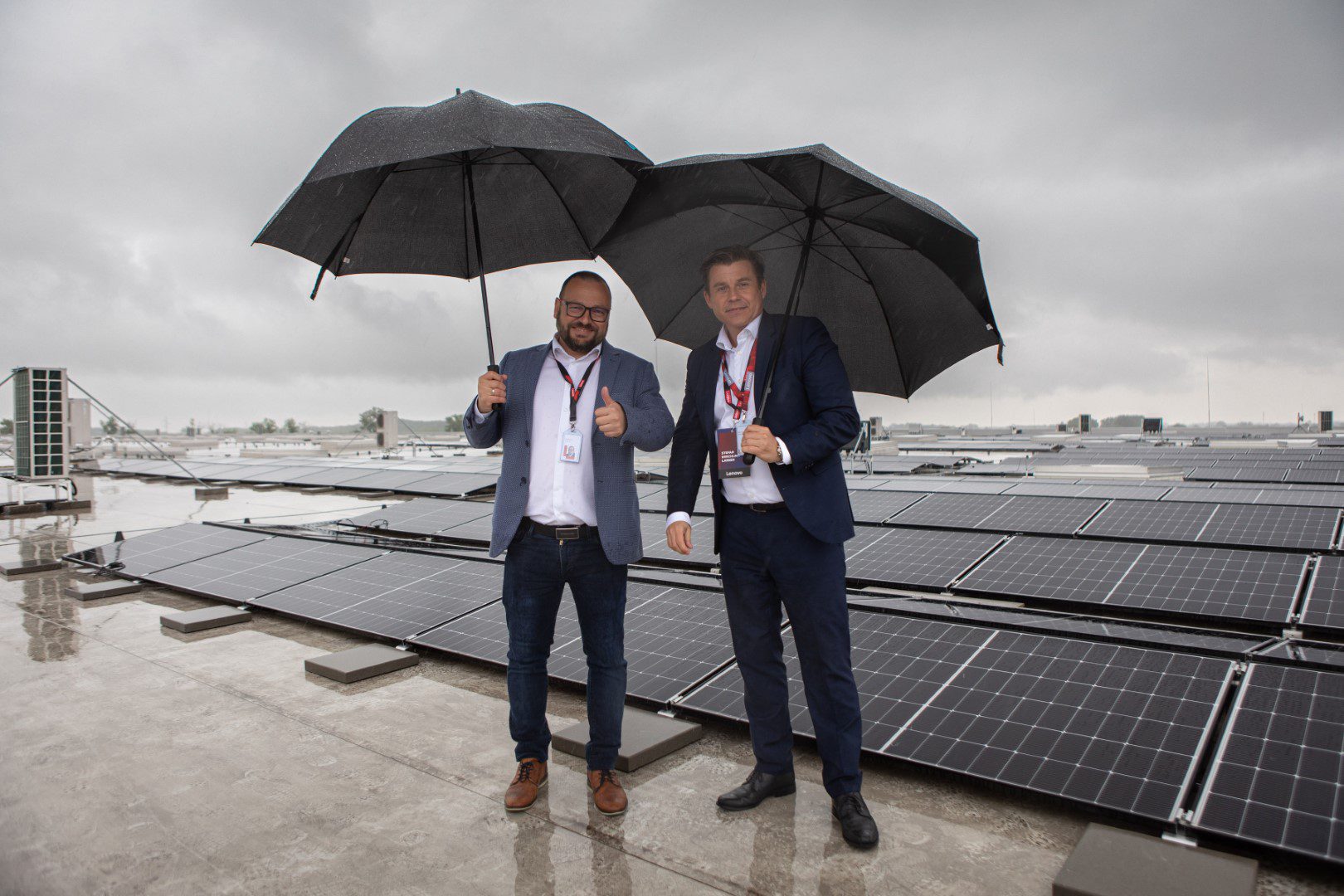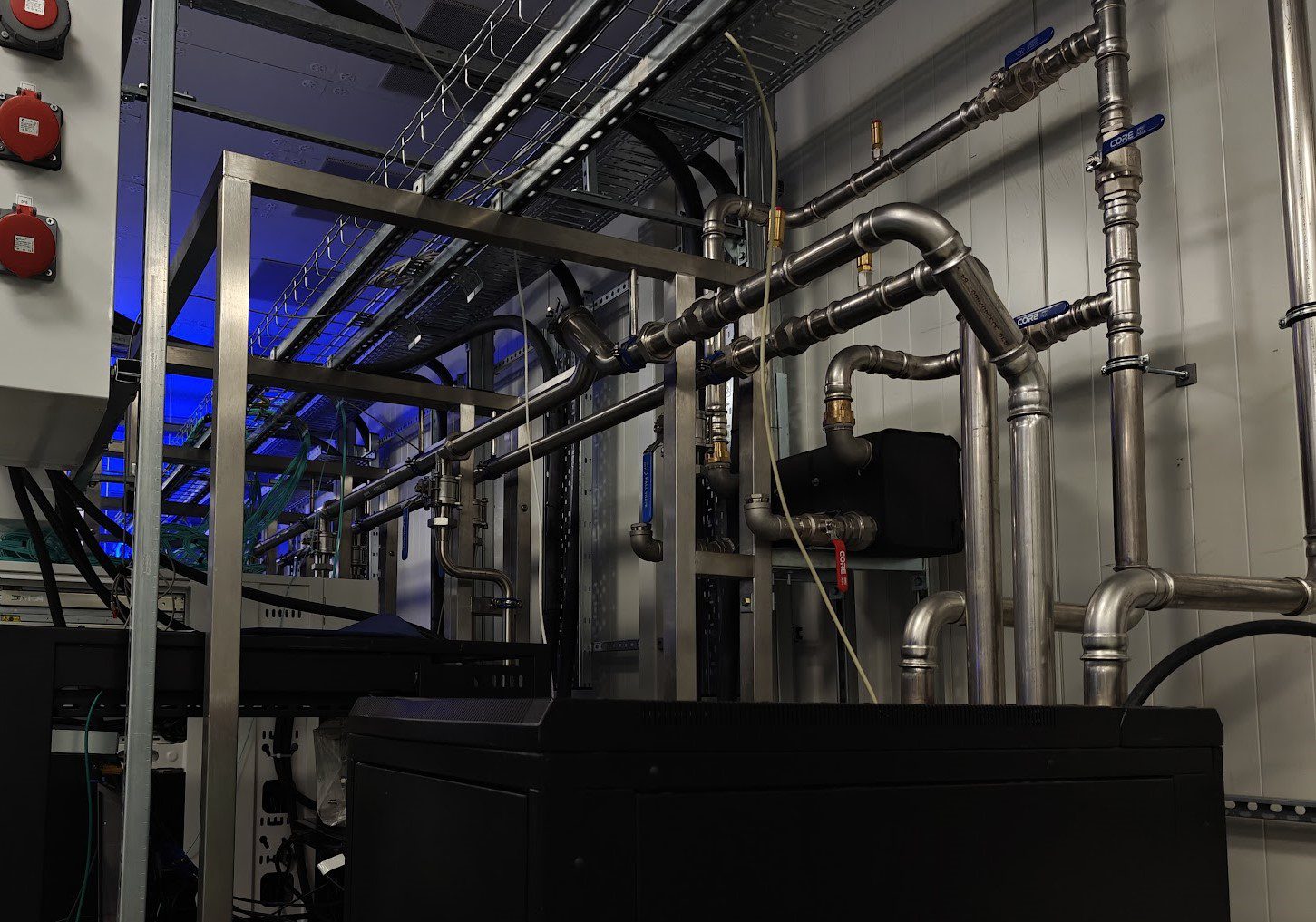Your Lenovo server: Made in Europe using 5,072 solar panels
- May 7, 2024
- 0
Lenovo built a large new factory in Hungary during the Corona crisis so that workstations and servers have “Made in Europe” on the packaging. However, that is not
Lenovo built a large new factory in Hungary during the Corona crisis so that workstations and servers have “Made in Europe” on the packaging. However, that is not


Lenovo built a large new factory in Hungary during the Corona crisis so that workstations and servers have “Made in Europe” on the packaging. However, that is not the main reason: the location must support specific ecological goals and ensure a robust supply chain.
There are 5,072 solar panels on the roof of Lenovo’s brand new desktop and server factory in Hungary, equivalent to about 3 MW of production. Today the yield is closer to zero: Budapest and the surrounding area are hidden under a thick layer of clouds from which moisture constantly drips. We wonder if it was wise to climb to the roof of the site to see the panels.
The miserable weather doesn’t stop Szabolcs Zolyomi, Supply Chain Site Leader, and Stefan Larsen, Global Sustainability Services Leader, from activating the installation with the push of a button. Symbolically, anyway. “To turn the system on and off, we have to close the factory, and we won’t do that,” laughs Zolyomi. He immediately assesses the weather positively: “Solar panels in the rain, that shows how unstoppable we are.”

The assembled press is at the Hungarian factory for the activation of the solar panels, but Lenovo actually wants to emphasize its broader focus on sustainability, based on scientifically based target initiative. The positive influence of the location on the stability of the European and global supply chain also proves to be an important topic.
Solar panels in the rain illustrate how unstoppable we are.
Szabolcs Zolyomi, Head of Supply Chain Site Lenovo Budapest
“In 2020, this place was still a wheat field,” explains Zolyomi. “Despite the restrictions during Covid-19, we put construction on hold for ten months. Another seven months later, the production lines were together with the AI & HPC Innovation Center. Today we are trying to increase production by increasing density.”
Covid has exposed the limits of the global supply chain. The Budapest factory, which Lenovo had been planning to build since 2016, is intended to make it more robust. The computer specialist supplies servers, HPC hardware and workstation desktops to the EMEA region from its factory, with orders available from any factory anywhere in the world. However, the components with which the employees assemble hardware in two shifts still predominantly come from the Far East.
“We try to have at least two sources for all components,” said Brian Jaeger, director, supply chain services. “This is completely fine for our own products. The parts delivered consist of hundreds of thousands of components. 95 percent of their offerings are now diversified.”
Protected from the rain, we are surprised at the relative calm in the factory. Servers and desktops are humming in test setups and employees are busy on various production lines, but overall it is quite quiet in the spacious factory hall. Lenovo logos are featured prominently, along with inspiring photos of data centers like Mare Nostrum in Barcelona, for which this site supplies the nodes and racks.


“Large orders are assembled on an assembly line,” says Zolyomi. “Everyone on the line performs an action and the entire production line is optimized so that there are no bottlenecks. For individual orders, the warehouse employees first collect all the components in one Sushi box (a large box with compartments for various components, editor’s note), after which a specialist assembles the entire server to size.”
On the ongoing production line, we see how employees always complete a specific task. You install fans, hard drives or GPUs, after which the running server moves to the next station. Employees receive help from robots for recurring tasks, such as tightening certain parts.
The situation is different for individual orders. Others diligently fill containers with components from the huge warehouse, which are then sent via another conveyor belt to the specialized fitters. The whole thing is like a well-oiled machine in which everyone knows their role. Colored dust jackets further emphasize this role: white for production workers, light blue for quality control, yellow for trainers and red for supervisors. The signee walked around in a fashionably daring light green dress, typical of visitors. “That way you won’t suddenly be sent to work by an instructor,” laughs Zolyomi.

The entire factory has been extensively digitalized. Zolyomi: “All components are scanned before installation. Scanning an incorrect part will result in an error code. Product inventory decreases as parts are scanned. Because each part has a unique code, we can trace any problems afterwards.”
Everyone works with the factory’s digital brain, which uses analytics to determine which orders are being processed and when. “These algorithms run in a data center on site in the factory,” says Jaeger, although we don’t get to see the digital brain during our visit.
Each workstation is equipped with a screen and a barcode scanner: All employees can see what they have to do at all times. There are displays at central locations in the factory that use charts and color codes to track how smoothly everything is running.
“The factory would undoubtedly run without this comprehensive digitalization,” says Zolyomi. “But that’s like driving a car on the highway without a speedometer, fuel gauge or mirrors. You know better what you’re doing with all these tools.”
In the middle of the factory hall we find a smaller building. There is no mention of the peace that exists elsewhere. Hundreds of servers in dozens of racks are screaming. Here Lenovo injects the software and tests the hardware.
Some racks are traditionally cooled, but the water-cooled Neptune servers are also available. There are also HPC servers from the Innovation Center in the back corner, which experts can access via a VPN connection. The heat generated by these water-cooled systems flows through the radiators of the site’s meeting rooms.


“The entire building was designed with sustainability in mind from day one,” Zolyomi says during a presentation in one of these meeting rooms. “We not only use the residual heat from the servers, but also cool with outside air where possible. The building is well insulated and controlled by an intelligent system that detects temperature and humidity and can turn itself on and off.”
Lenovo displays all real-time data about the factory’s water and electricity consumption at the entrance to the production floor for employees to monitor. “This is how we create a culture of sustainability among our employees,” says Zolyomi.
At the back of the factory, the assembled and tested servers are packaged as sustainably as possible. The employees scan the products again, then they are picked up by a vacuum suction device so that the employees can guide them to the box without endangering their own backs.

Whenever possible, Lenovo bundles multiple devices. Racks filled with nodes are returned to the original packaging and only the label is changed if the end customer agrees. All new packaging materials come from local suppliers. “Made in Europe“ all the boxes with finished servers and workstations say proudly.
“We ship almost all finished systems by truck,” says Jaeger. “Only in exceptional cases, when things have to go quickly, do we decide to ship by air freight.” This also fits with Lenovo’s sustainability strategy.
On the way to the exit we see the employees continuing to build diligently. “Fifteen nationalities work here,” says Zolyomi proudly. “This factory has created more than 1,000 jobs in the region and the workforce has grown by twenty percent in recent years.” Lenovo may be a Chinese company with American roots, but the ambition for a strong European anchor is visible.
On the way to the exit we see how it rains continuously. On a sunny day, the solar panels on the roof generate many times the energy the site needs to operate. Lenovo then feeds this into the Hungarian network, as the location does not have large batteries. Nobody really dares to estimate how many kilowatts solar panels generate today.
Source: IT Daily
As an experienced journalist and author, Mary has been reporting on the latest news and trends for over 5 years. With a passion for uncovering the stories behind the headlines, Mary has earned a reputation as a trusted voice in the world of journalism. Her writing style is insightful, engaging and thought-provoking, as she takes a deep dive into the most pressing issues of our time.